- 02 9712 1736
- [email protected]
- 212 Great North Road, Five Dock, NSW 2046
- Open 7 days a week
Neck pain is a common condition that affects up to 50% of the population at some point in their lives. In Australia, neck pain is the fourth leading cause of disability and is a leading cause of absenteeism from work accounting for 25% of all sick days. Read on to learn more about some of the most common causes of neck pain and how to prevent neck pain.
At Five Dock Osteopathic and Chiropractic Centre, we believe that it is important for everyone to understand factors that may cause neck pain and stiffness to gain insight into methods to prevent neck pain and stiffness. With this insight, you will also be able to establish when it is important to seek care sooner rather than later.
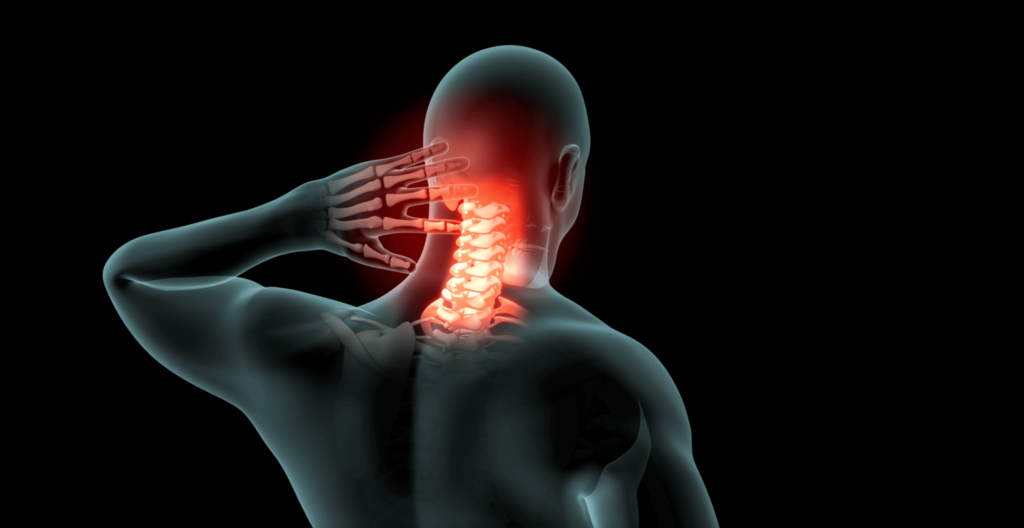
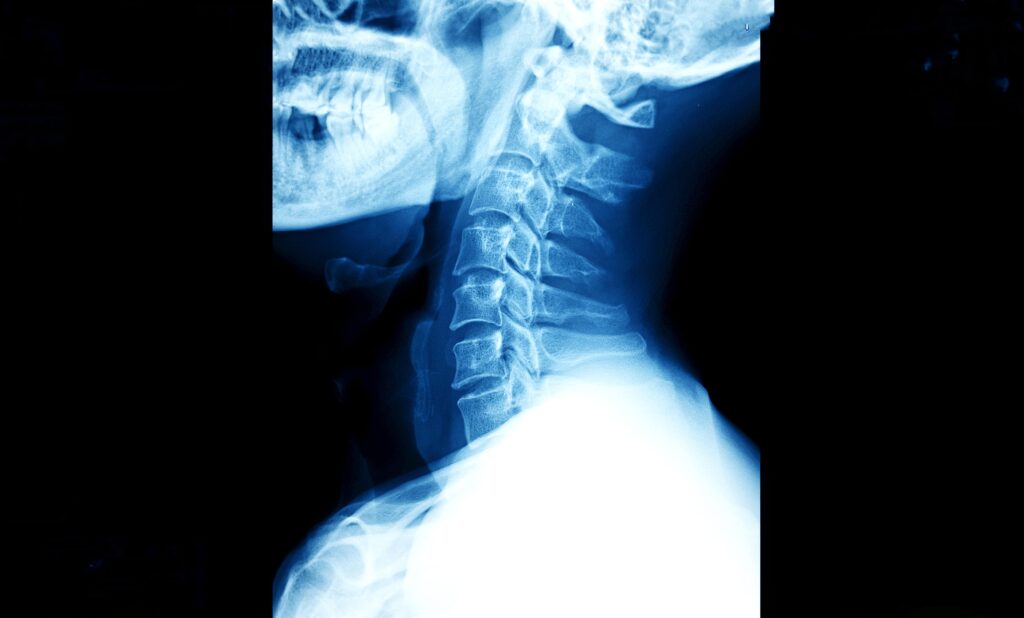
Your neck (cervical spine) consists of the eight bones and supporting muscles, ligaments, fascia and tendons of your spinal column between your upper back and head. Your spinal cord is protected by the bones of your neck between your head and upper back.
Your neck has a normal range of movement that allows you to look ninety degrees left and right, bend to the left and right, and up and down. These simple movements can also be combined to give you the more complex movements you can perform.
Your neck also supports the nerve and blood flow between your upper body and head. Neck pain or neck injury is defined as any damage to the bones, soft tissues or support structures in this area.
Most neck pain feelings depend on the underlying structure causing pain. For example, mild muscle spasm is often described as a dull achy persistent pain with no radiating pain. Muscle pain will feel better if you gently stretch or through gentle exercises of the muscle. Cervical radiculopathy is often described as a sharp, severe pain with referral-creating arm, upper back and neck pain. You may also feel numbness or a burning sensation down your arm. The intensity of your neck pain depends on the structure injured and the time you have been suffering neck pain. For instance, with long periods of neck pain, you will develop chronic pain. Chronic pain causes a change in how your brain registers your pain. It is always best if you are experiencing long-term neck pain to seek medical care.

A healthcare professional diagnoses neck pain. When you are experiencing neck pain, a detailed medical history, physical exam and medical imaging tools (MRI or nerve conduction studies) will be used to diagnose the root cause of your neck pain. Your healthcare provider will then recommend medical care from over-the-counter medications, alternative therapies, and mainstream care like chiropractic, osteopathic or physiotherapy care. Surgery may be required in more severe cases, such as serious injury or cervical radiculopathy.
Neck pain may be caused by various factors, from poor posture to injuries and medical conditions. Many cases of neck pain can be treated effectively with conservative care and manual therapy (chiropractic, osteopathy or physiotherapy) without the need for more invasive treatments. Here are some common causes of neck pain and stiffness that may be treated using conservative care and manual therapy:
One of the most common causes of neck pain is poor posture. When we sit or stand with our head forward and shoulders hunched, we put a lot of strain on the neck muscles, ligaments, and upper back, leading to neck stiffness and pain. If you work at a desk for long hours, taking breaks and stretching your neck and shoulders regularly is essential to avoid developing poor posture and prevent making your stiffness and neck pain worse.
Your chiropractor can help you identify the underlying cause of your poor posture and teach you exercises to strengthen your neck muscles and stretches to improve neck and upper back mobility. They can also show you how to set up your work desk ergonomically, making it easier for you to maintain good posture throughout the day.
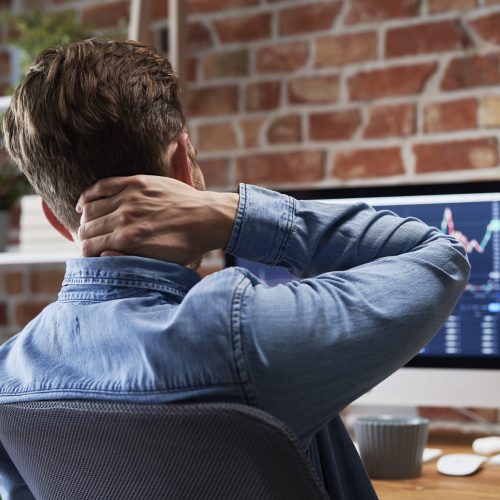

Another common cause of neck pain is muscle strain. This can occur due to sudden movements or overuse of the neck muscles. Carrying out activities in awkward postures, such as sleeping in an awkward position or carrying heavy bags on one shoulder, can also lead to muscle strain and/or worsen your neck pain. If you’re experiencing muscle strain, try applying heat to the affected area, taking over-the-counter pain relievers, and avoiding activities that exacerbate the pain.
Your chiropractor can teach you exercises to stretch and strengthen the muscles in your neck, which can reduce pain and prevent further strain. They may also recommend other treatments such as massage, heat or cold therapy, or electrical stimulation to help alleviate pain.
Injuries to the neck, such as whiplash from a car accident or a fall, can also cause neck pain due to the sudden jerking motion of the head. These injuries can cause damage to the muscles, ligaments, and nerves in the neck, leading to pain and stiffness. For example, suppose you’ve been in an accident and suffer neck pain. In that case, it’s important to seek medical attention immediately to rule out serious injuries, such as spinal cord injuries.
If you have been ruled out for serious injuries, manual therapy can be an effective treatment for injuries such as whiplash, helping reduce pain and improve range of motion. Your chiropractor may recommend exercises to stretch and strengthen the neck muscles and manual therapy techniques to improve mobility in your spine.
In some cases, neck pain may be accompanied by weakness and numbness or tingling in the arms, hands, legs, or feet and may also be associated with problems with balance and coordination. This is often a result of cervical stenosis, the medical term to describe narrowing in the spinal canal or foraminal nerve root exits in the neck. Resulting in compression of the spinal cord and/or nerve roots or a pinched nerve, leading to neck pain.
They are most commonly related to age-related degeneration and is observed in those over the age of 50. Here are some common causes of cervical spinal stenosis due to age-related degeneration:
Joints in the neck begin to degenerate with age, leading to arthritis, osteoarthritis, or bone spurs. This can cause inflammation and pain in the neck, as well as stiffness and decreased range of motion. Growth of bone spurs may contribute to the narrowing of the spinal canal resulting in compression of the spinal cord and/or nerve roots or a pinched nerve. This can cause pain and discomfort, especially when moving the head.
If you have arthritis in the neck, your doctor may recommend medication, physical or manual therapy (chiropractic, osteopathy or physiotherapy), or other treatments to alleviate the pain. While there is no cure for arthritis, manual therapy can effectively reduce pain and improve mobility. Your chiropractor can help you develop a safe and effective exercise program for your specific condition.
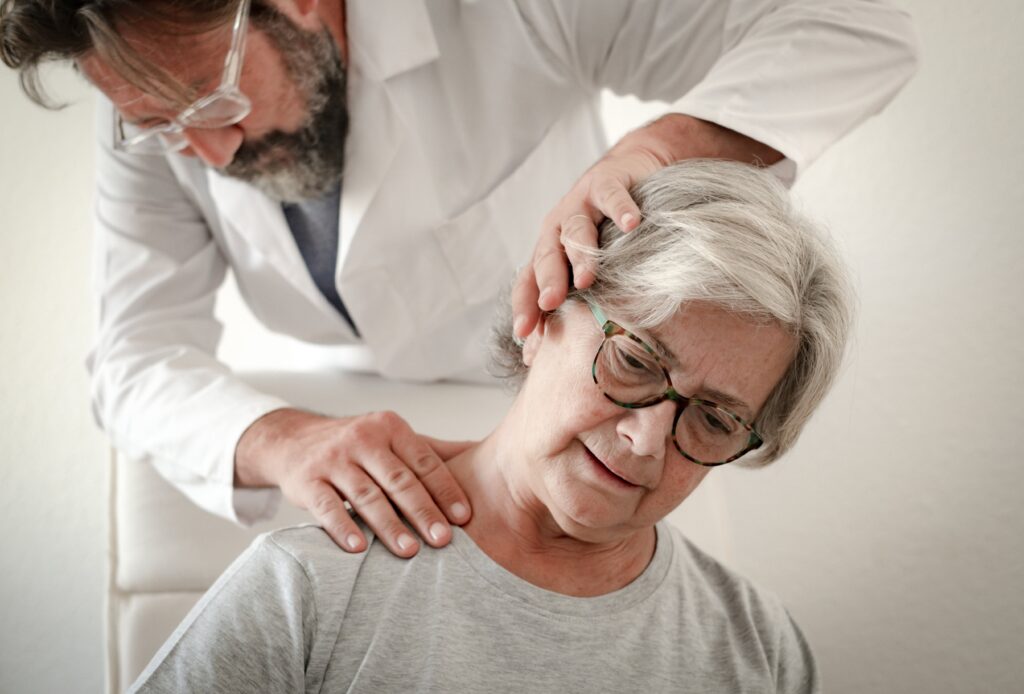
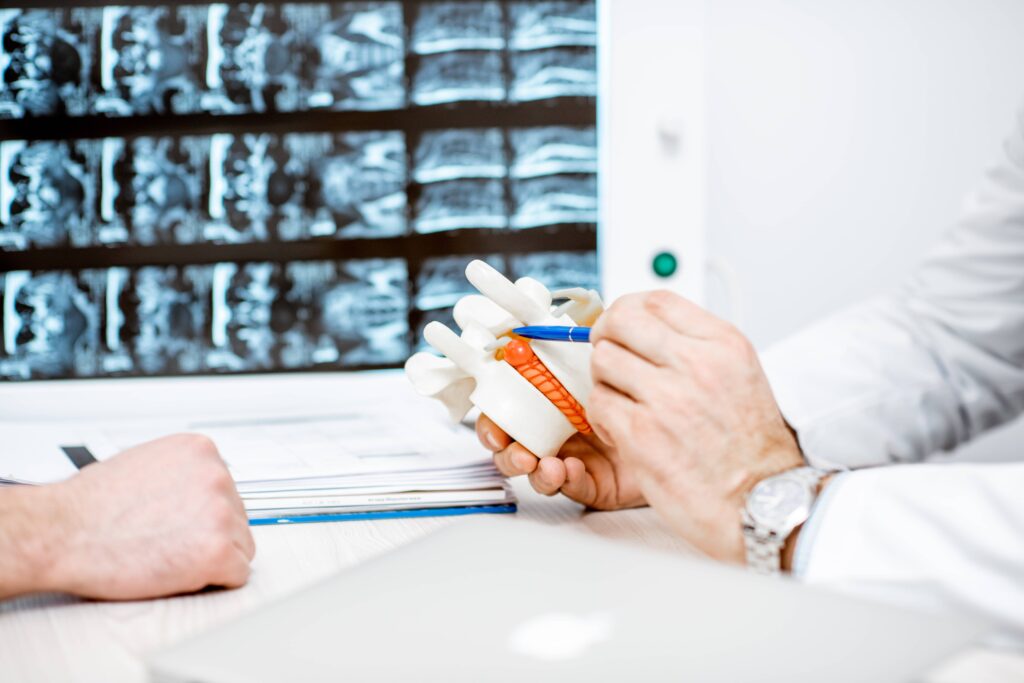
As we age, the discs in our neck can begin to lose moisture and become less flexible, leading to degeneration and possible bulging or herniation of the disc material. This can cause compression of the spinal cord and/or nerve root in the neck, or a pinched nerve, leading to pain, weakness, and numbness in the neck, arms, and hands. If you have a herniated disc, your doctor may recommend rest, medication, manual therapy, or surgery to alleviate the pain.
Manual therapy (chiropractic, osteopathy or physiotherapy) can help effectively treat bulging or herniated discs, helping to alleviate pain and improve the range of motion. Your manual therapist may recommend exercises to strengthen the neck and back muscles and manual therapy techniques may be used to relieve pressure on the affected nerve.
It is important to keep in mind that cervical stenosis can also be caused by a few other factors, excluding age-related degeneration, such as spinal injuries, tumours, and congenital abnormalities. As such, if you are experiencing neck pain or other symptoms related to cervical spinal stenosis, it is important to seek medical attention promptly to determine the underlying cause and develop an appropriate treatment plan.
While treatment for cervical stenosis typically involves conservative measures such as physical therapy, exercise, and medications to manage pain and inflammation. In severe cases, surgery may be necessary to relieve pressure on the spinal cord or nerve roots. Post-surgery rehabilitation is an important step in care.
Medications may be used to relieve neck pain, but it is important to consult a healthcare provider before taking any medication. The appropriate medication for neck pain may depend on the underlying cause of the pain, as well as any other health conditions that the individual may have that is why it is important to conduct a full examination and in some rare cases, a blood test may be required.
Here are some types of medication that often is helpful with neck pain:
NSAIDs, such as ibuprofen and naproxen, can help reduce inflammation and relieve pain. Doctors most commonly use medication for neck pain.
Muscle relaxants can help reduce muscle tension and spasms, which can contribute to neck pain. These medications may be prescribed for short-term use to help alleviate pain and promote relaxation.
Narcotic pain medications, such as codeine or oxycodone, may be prescribed for severe neck pain. However, they are generally reserved for short-term use due to their potential for addiction and side effects.
Topical treatments, such as creams, gels, or patches that contain lidocaine, capsaicin, or menthol, can be applied directly to the skin over the affected area to help alleviate pain. these are most commonly used in the treatment of muscle spasm.
It is important to remember that medication alone may not be enough to treat neck pain and certainly is not a long-term solution to manage neck pain. Physical therapy, exercise, and other non-pharmacological treatments may be necessary to manage neck pain effectively.
A healthcare provider can help determine the appropriate treatment plan for an individual based on their specific needs and underlying conditions.
Although most cases of neck pain are not serious and can be treated with conservative care or physical therapy, some more rare of neck pain require medical emergency attention. Here are some of the more serious causes of neck pain that require immediate medical attention:
Meningitis is an infection of the lining surrounding the brain and spinal cord. Neck pain is a common symptom of meningitis, along with fever, headache, and a stiff neck. If you experience these symptoms, seek medical attention immediately, as meningitis can be life-threatening.
A heart attack can cause neck pain, especially in women. Other symptoms may include chest pain, shortness of breath, and lightheadedness. Seek emergency medical attention if you suspect a heart attack.
A stroke can cause neck pain, especially if it affects the vertebrae or blood vessels in the neck. Other symptoms may include weakness or you may feel numbness on one side of the body, confusion, and difficulty speaking. Seek emergency medical attention if you suspect a stroke.
A spinal cord injury can occur due to trauma, such as a car accident or a fall. Neck pain and weakness or numbness in the arms or legs can be a symptom of a spinal cord injury. Seek emergency medical attention if you suspect a spinal cord injury.
A tumour in the neck or spinal cord can cause neck pain, especially if it is pressing on a nerve. Other symptoms may include weakness or numbness in the arms or legs, difficulty walking, and loss of bladder or bowel control. Seek medical attention if you suspect a tumor.
Treatment and management options for neck problems can be as diverse as the injuries themselves. Our and your first goal for any management approach is to ease the neck pain as fast as possible.
For minor neck pain present for less than 24hrs caused for example by spending too much looking at our computer screen, simple at-home relaxation techniques, over-the-counter pain medication or frequent breaks can ease neck pain.
Another commonly used at-home remedy is purchasing a special neck pillow designed to ease pain and relieve tension while sleeping. you can buy a special neck pillow online, in pharmacies or sometimes from your treating healthcare professional.
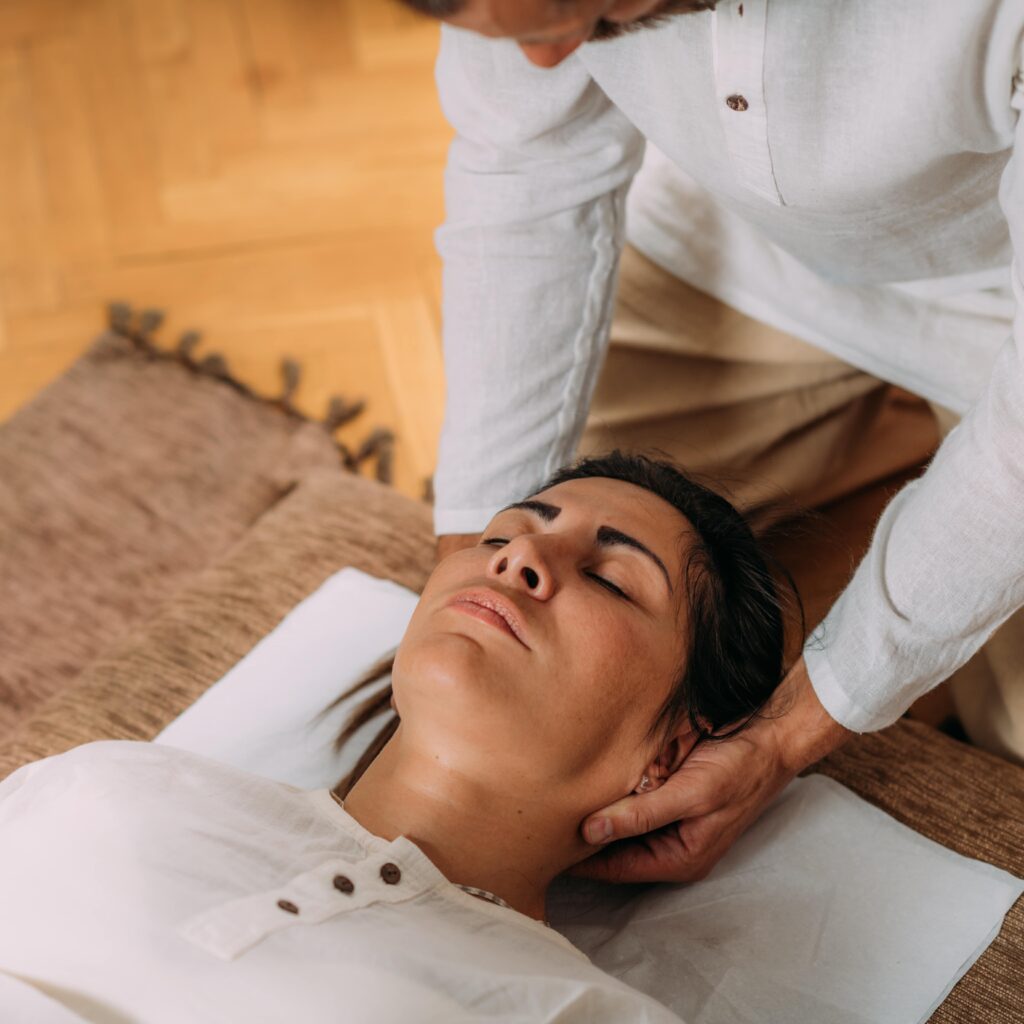

For other cervical spine injuries like a whiplash injury, spinal column pathologies, or even minor muscles spasm where your symptoms persist for more than 24hrs. a physical exam by a trained health professional will be needed.
Once this exam has been completed, we find using soft tissue massage techniques, mobilisation/adjustments, and at-home exercises (Eg. how to practice good posture) the most effective way to relieve tension from your stiff neck.
Once the pain has eased, we focus on functional mobility and control of your upper back and shoulders. if these regions are stiff from working in the same position all day, they will be putting pressure on your cervical spine. this chronic stiffness will lead to a decrease in proprioception and joint control, which will increase the frequency and severity of our painful neck symptoms.
The type of neck pain you are experiencing determines the length of time until you are healed. It is important to consult a healthcare professional to establish the best course of care for you. For our approach to neck and shoulder care read our treatment section.
Your neck, upper back, shoulder and arm all work together. It is common for patients suffering from neck pain to experience pain in their upper back, shoulder and arm. This is due to the neck muscles and nerves originating in your neck and travelling out your upper back, shoulder and arm. This transfer of neck pain out further from your neck is known as referred pain. Often causes of neck pain also be due to shoulder injuries.
When you injure your shoulder, your shoulder blade muscle spasm to protect your shoulder. This protection mechanism is designed to stop you from causing further shoulder injury. However, in the process, the muscles between your shoulder blade and neck become stiff, creating a stiff neck and neck pain. Thinking of the shoulder in any neck pain or stiff neck symptoms is always important.

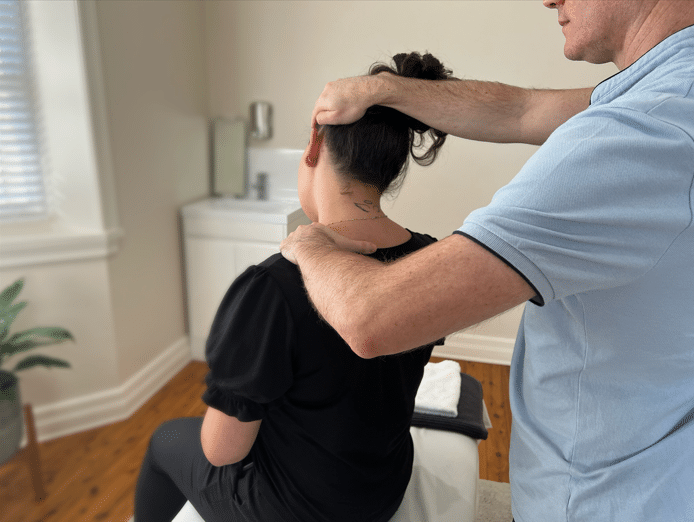
About
Five Dock Osteopathic & Chiropractic is located in Canada Bay, in Sydney’s Inner West. Servicing suburbs including Burwood, Croydon, Drummoyne, Five Dock, Haberfield, Concord, Abbotsford, Chiswick, Leichhardt, Wareemba, Russell Lea, Summer Hill, Strathfield.
Clinic hours
Monday, Tuesday, Thursday 7AM – 7PM
Wednesday, Friday 7AM – 6PM
Saturday 7AM – 2PM
Sunday 8AM – 2PM
Contact details